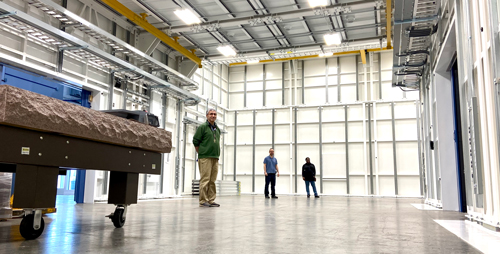| Techniques | Wide- and small-angle scattering, coherent diffraction, absorption- and diffraction-based tomography |
| Photon beam energy | 35-120 keV |
| X-ray spot size | 200 nm to several mm |
| Working distance | 1 m |

Think about things in which you don’t want invisible flaws or stresses: jet turbine engine disks, fuel assemblies for nuclear energy, a titanium implant that supports an adjacent human bone, and electrodes in battery materials. Engineers and material scientists would like to anticipate potential cracks, voids and other hot spots in these materials to improve their lifetime prediction as well as for energy efficiency and safety.
This is where the High-Energy X-ray Microscope (HEXM), one of two super-sized beamlines housed in the new Long Beamline Building (LBB) at the upgraded Advanced Photon Source (APS), will shine.
HEXM is the ultimate zoom-in, zoom-out microscope. Using it, scientists can study materials as big as a centimeter, which represents bulk-scale behavior, and zoom in to study these materials on the grain scale and down the atomic level. This can be done non-destructively for essentially any material. Basically, it will allow researchers to look for smaller needles in bigger haystacks.
Key features of the 600-foot-long HEXM beamline include a superconducting undulator, high resolution monochromator, beam focusing and expanding optics and a large end station (20-ID-E) inside the LBB. When coupled with the upgrade’s highly coherent X-ray source, large samples will be measurable with both direct-beam and diffracted-beam imaging techniques. These techniques utilize both lens-based and lensless imaging modalities.
The HEXM end station is located next to the new Activated Materials Laboratory (AML), which is separately funded by the DOE Office of Nuclear Energy, to enhance the study of low-activity irradiated materials at the APS while still meeting stringent safety standards.
In addition to providing high penetration power, the high-energy X-rays enable measurements in air, rather than vacuum, which means scientists can study a wide range of in-situ environments. For example, scientists will use HEXM to study safely the individual or combined effects of time, temperature and pressure on metal alloys used for aerospace or in activated materials used for nuclear structural applications or fuels. They will be able to see how cracks or other hot spots form due to electrochemical cycling in full-scale batteries. They will also be able to measure structure while a material is being made or altered, such as during additive manufacturing or welding.
The design of a new and improved material relies on multi-scale structural information gathered before, during and after it is made, as well as under service conditions. That’s the type of information HEXM will be able to provide.
BEAMLINE CONTACT:
Jon Almer, [email protected]
